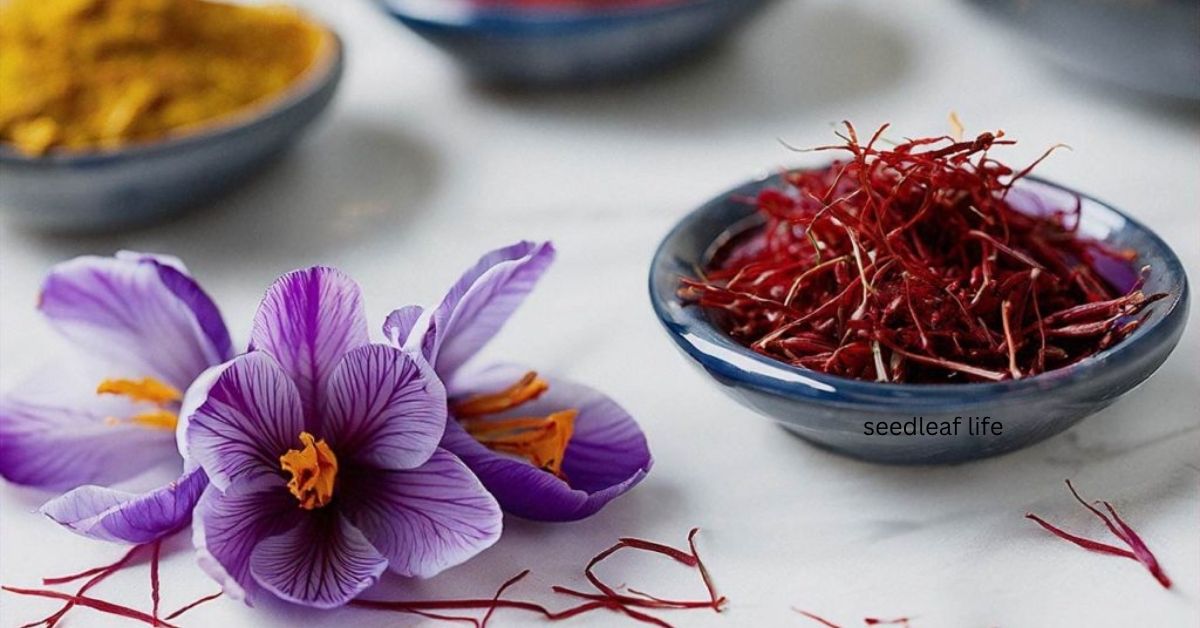Saffron isn’t just a spice. It’s a treasure! Harvested from the beautiful Crocus sativus flower, it holds the title of the world’s most expensive spice. But where does saffron grow?
Join us as we uncover the rich landscapes where saffron flourishes and learn why this spice is beloved by chefs and home cooks alike. You’ll discover not only its origins but also tips on how to use saffron in your own cooking adventures.
Where Does Saffron Grow?
Where does saffron grow refers to the specific regions and climates where the saffron crocus (Crocus sativus) thrives.
| Country | Main Region | Share of Global Production | Growing & Harvesting Months | Key Features |
| Iran | Khorasan Province | 90% | Planting: June–August Harvesting: October–November | Ideal dry climate, best quality saffron |
| India (Kashmir) | Pampore, Pulwama | 5–7% | Planting: May–June Harvesting: October–November | Deep color, strong aroma, handpicked threads |
| Spain | La Mancha | 2–3% | Planting: June–July Harvesting: October–November | Cultural spice, distinct flavor |
| Greece | Kozani Region | 1% | Planting: June–August Harvesting: October–November | Floral scent, bright color |
| Afghanistan | Herat & nearby areas | 1% | Planting: July–August Harvesting: November–December | Emerging producer, high-quality saffron |
As you can see, saffron grows in several regions across the world — each offering its own charm and flavor. Among all saffron production countries, Iran remains the top producer, thanks to its dry climate and fertile Khorasan soil. Kashmir in India follows closely, known for its rich color and aroma.
Spain’s La Mancha treats saffron as a cultural treasure, while Greece’s Kozani region produces a fragrant and bright variety. Afghanistan has also emerged as a new saffron-growing region, where farmers are embracing this golden crop for its high value. These countries together highlight where does saffron grow, making it one of the most special and loved spices in the world.
Understanding Saffron Seeds – The Foundation of Saffron Growing
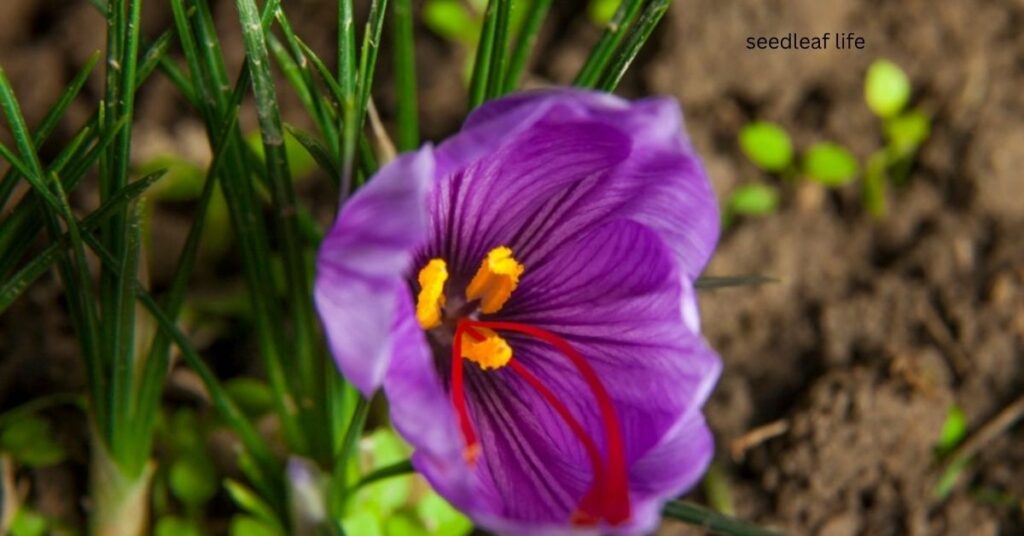
To truly understand where does saffron grow, you first need to know about its corms — the true “seeds” of the plant. These bulb-like corms thrive in well-drained, sunny regions and form the foundation of saffron cultivation, giving rise to the vibrant flowers that produce the golden spice.
If you’re curious about how seeds transform into healthy plants, check out this detailed guide — From Seed to Plant: A Green Miracle.
What Are Saffron Seeds (Corms) and How Do They Grow?
- Saffron seeds are actually corms, small bulb-like structures that store nutrients for plant growth.
- These corms remain dormant until the right season triggers their growth.
- Once planted, they develop roots and leafy stems, leading to the stunning Crocus sativus flowers.
- The purple blooms produce saffron’s famous red stigmas — the part used as the spice.
- Saffron grows best in hot, dry summers and cool winters, common in Iran, Spain, and India.
- The climate balance of warmth and cold is essential for producing top-quality saffron.
How to Select Quality Corms for Successful Saffron Cultivation
- Choose firm, plump corms that are free from mold, rot, or damage.
- Larger corms usually produce more flowers and a better saffron yield.
- Buy only from trusted saffron suppliers to ensure purity and disease-free stock.
- Plant corms in well-drained, nutrient-rich soil to prevent root rot.
- Select a sunny location — saffron loves plenty of light and warmth.
- Avoid overwatering; saffron prefers moderate moisture and dry soil between watering sessions.
- Starting with high-quality corms ensures a healthy, long-lasting saffron garden.
Ideal Conditions for Saffron Growing
Ever wondered where does saffron grow and what makes it flourish so beautifully? The secret lies in its love for sunny skies, well-drained soil, and just the right balance of warmth and coolness — nature’s perfect recipe for the golden spice!
Best Soil for Saffron Growth and Drainage Needs
- Saffron thrives in well-draining soil, which prevents rot and disease.
- Loamy or sandy soils are ideal because they allow excess water to flow away easily.
- Avoid clay or heavy soils that hold too much moisture.
- Mix in organic matter or compost to improve soil structure and nutrient content.
- The best soil pH for saffron is slightly acidic to neutral (around 6.0–7.0).
- Remember: Where does saffron grow best? In soils that are rich in nutrients yet drain quickly!
Ideal Saffron Growing Temperature and Climate
- Saffron grows best in a mild, balanced climate — a mix of warmth and coolness — which explains where does saffron grow most successfully.
- The ideal temperature range is between 60°F to 70°F (15°C–21°C).
- Hot, dry summers and cold winters create the perfect growth cycle for saffron corms.
- Cooler temperatures help corms rest and prepare for autumn flowering.
- Regions like the Mediterranean, Iran, Kashmir, and parts of California provide perfect conditions.
- Avoid tropical or overly humid climates — saffron prefers dry air and sunlight.
Perfect Season and Timing for Planting Saffron Corms
- Late summer to early fall (August–September) is the best time to plant saffron corms.
- This gives corms enough time to establish roots before winter cold sets in.
- By October or November, they start blooming with vibrant purple flowers.
- Planting at the right time ensures strong growth and higher flower yield.
- Avoid planting too early in summer or too late in winter — it can affect flowering.
- Proper timing = a healthy saffron garden and maximum harvest success.
Step-by-Step Guide – How to Grow Saffron Successfully
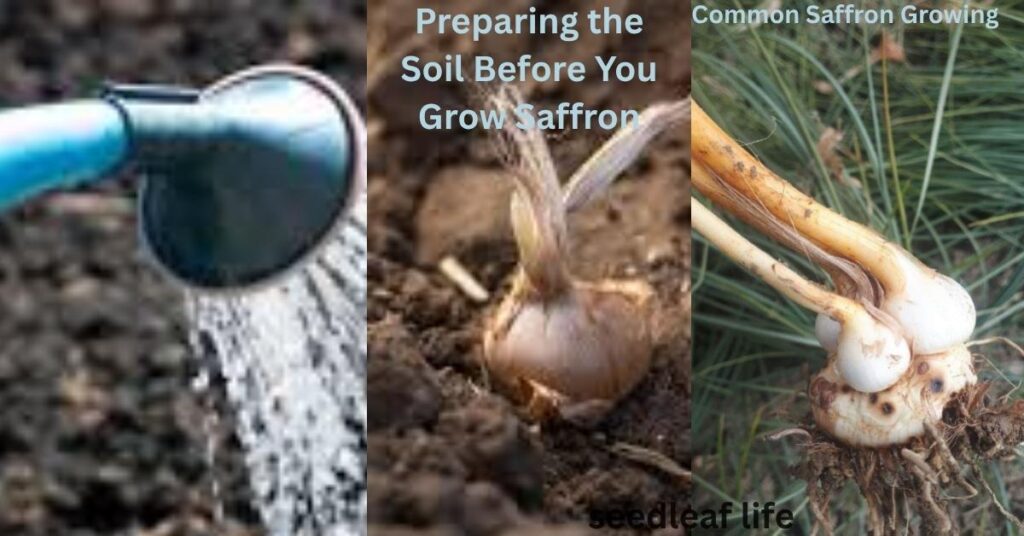
Ever wondered where does saffron grow and how you can cultivate it yourself? This step-by-step guide will walk you through everything — from preparing the soil to harvesting those precious red threads successfully.
Preparing the Soil Before You Grow Saffron
- Think of soil as your saffron’s home — it needs to be cozy, airy, and well-drained.
- Choose a sunny spot with sandy or loamy soil, because saffron doesn’t like wet feet.
- Before planting, mix in some compost or organic matter. It boosts nutrients and helps roots breathe.
- If your soil feels too heavy or sticky, add sand to make it drain better.
- Try testing your soil’s pH level — saffron grows best when it’s slightly alkaline (around 6 to 8).
- A little effort here goes a long way. When your soil is healthy, your saffron flowers will thank you with vibrant blooms.
Watering and Caring for Saffron Plants Properly
- Here’s the good news — saffron doesn’t demand too much water.
- Just check the soil; if it feels dry, give it a gentle drink. If it’s still moist, wait a few days.
- Too much water is saffron’s biggest enemy — it can cause the bulbs (corms) to rot.
- During the blooming season, light watering every few days is enough.
- Keep an eye out for weeds; they steal nutrients from your plants. Pull them out gently.
- You don’t need to fertilize often — saffron is a low-maintenance plant that thrives on balance.
- Be patient. With the right care and attention, those little corms will reward you with golden threads of saffron.
Common Saffron Growing Problems and Their Solutions
- Bulb Rot: If your saffron bulbs start softening or rotting, it usually means too much water. Try letting the soil dry out completely between watering — saffron prefers it that way.
- Pests Like Aphids or Mites: These tiny bugs can sneak in during humid weather.
Don’t worry — a gentle soap and water spray or a dash of neem oil usually does the trick. - No Flowers Appearing: If your saffron isn’t blooming, it might be stressed — maybe the soil’s too wet, too cold, or lacking nutrients.
Check the basics: sunlight, watering schedule, and soil health. - Remember, saffron isn’t a high-maintenance plant — it just wants the right environment.
- Once you understand where saffron grows best and what it needs, it will reward you with the most magical harvest.
Harvesting Saffron – The Most Delicate Stage of Saffron Growing
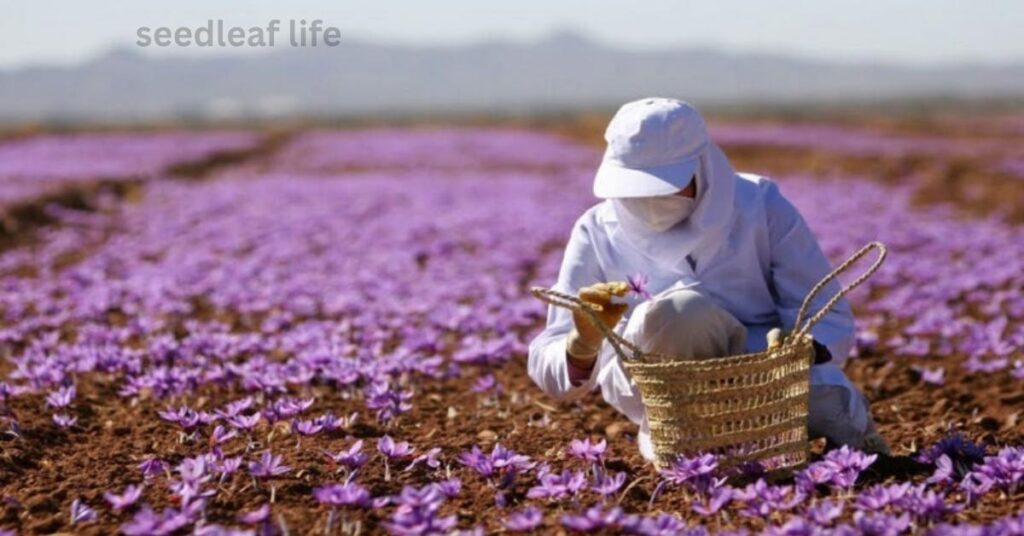
When you discover where does saffron grow, you’ll also learn that harvesting it is the most delicate stage — a moment of precision and patience where each golden thread is carefully gathered by hand.
When to Harvest Saffron Flowers for Best Quality Threads
Harvesting saffron is truly an art — a process where timing and gentleness matter most. Here’s how to get it right:
- Pick early in the morning: Always harvest when the flowers are still closed. This helps protect the delicate red stigmas from sunlight and keeps their aroma strong.
- Watch the color: Deep violet blooms are your cue — they’re at their freshest and richest stage.
- Act quickly: The harvesting window lasts just two to three weeks, so check your plants daily during this time.
- Handle with care: Use your fingers to gently pluck the flowers — avoid damaging the fragile stigmas.
Think of it like collecting tiny jewels; each saffron thread is precious and requires your full attention.
How to Dry and Store Saffron After Harvesting
Once you’ve picked your saffron, the next step is drying — the secret to preserving its flavor and color.
- Spread gently: Lay the red threads on a clean cotton cloth or tray in a cool, shaded area.
- Let air do the work: Allow them to dry naturally for about 3–4 hours. Avoid direct sunlight or high heat, which can destroy the aroma.
- Store smartly: Keep your dried saffron in an airtight glass container in a cool, dark place.
- Let it rest: For the best flavor, wait a few weeks before using — saffron’s aroma deepens with time.
A little patience goes a long way — properly dried saffron can keep its golden color and luxurious fragrance for months!
Why Is Saffron Hard to Grow?
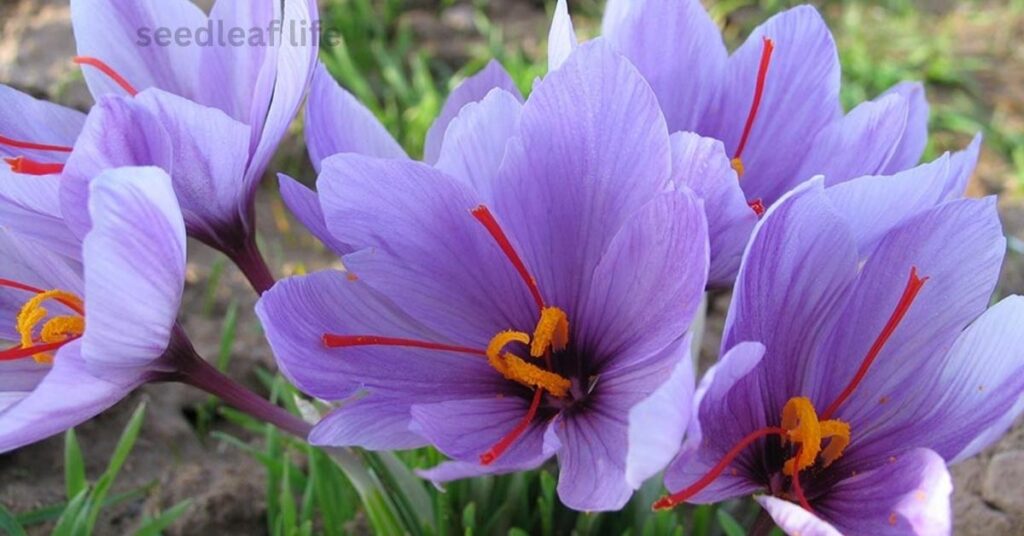
Saffron might be known as the “golden spice,” but growing it isn’t nearly as easy as sprinkling gold dust. Let’s break down the real reasons — discover where does saffron grow, why it’s so difficult to cultivate, and why every delicate strand is truly worth its weight in gold.
Labor-Intensive Harvesting and Low Yield
- Hand-picking only: Each saffron flower produces just three red stigmas, and every single one must be hand-harvested with precision.
- Time-consuming process: Farmers often spend hours bent over fields, collecting these delicate threads before sunrise — a truly laborious job.
- Tiny yield per flower: Nearly 75,000 flowers are needed to produce just one pound of saffron, which explains why it’s among the world’s most expensive spices.
- High labor cost: Since machines can’t do this delicate work, the process remains entirely manual, making saffron farming both slow and costly.
Growing saffron is not just agriculture — it’s artistry that demands patience, care, and precision, especially in the regions where does saffron grow best.
Sensitive to Soil, Temperature, and Weather Conditions
- Where does saffron grow, In regions with hot, dry summers and cold, mild winters — like Iran, Kashmir, and parts of Spain.
- Picky about soil: Saffron corms prefer well-drained, loamy soil; too much moisture can cause them to rot.
- Weather-sensitive: Sudden frost, rain, or extreme heat can easily ruin the crop — saffron simply doesn’t tolerate harsh conditions.
- Constant monitoring needed: Farmers must stay alert, adjusting irrigation and protection methods based on daily weather changes.
One unexpected cold night can undo months of effort — that’s how delicate saffron farming really is.
Short Blooming Period and Manual Workload
- Tiny harvest window: Saffron blooms for only 2–4 weeks each year, giving farmers very little time to collect the flowers.
- Manual workload: During the blooming season, the fields must be harvested every single day, often before sunrise.
- Physically demanding: The flowers are small and fragile, requiring careful handling — a true test of patience and dedication.
- A labor of love: Despite the exhaustion, many farmers describe saffron cultivation as a rewarding experience that connects them deeply with nature.
Every thread of saffron carries the story of effort, precision, and passion — that’s what makes it truly special.
What Is Saffron Used For?
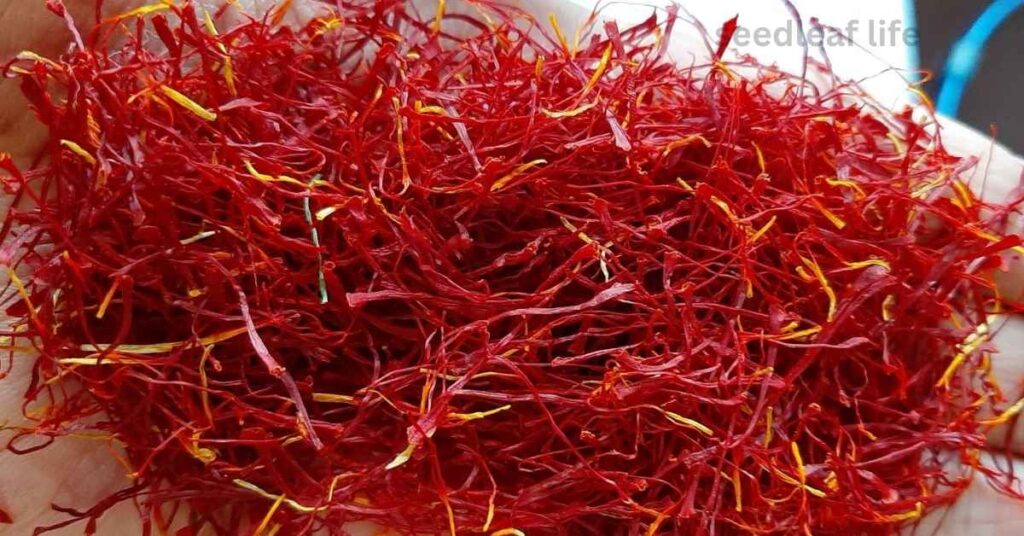
Saffron isn’t just a spice — it’s a lifestyle ingredient that brings beauty, flavor, and wellness together in the most luxurious way. Let’s explore what saffron is used for in food, skincare, and traditional healing around the world.
Culinary Uses – Cooking with Saffron for Rich Flavor
- Adds golden color and aroma: Just a few strands of saffron can turn an ordinary rice dish into a royal feast — think biryanis, risottos, and paellas that glow with a deep golden hue.
- Beloved by chefs worldwide: From Indian and Persian cuisines to Spanish and Mediterranean dishes, saffron adds a warm, earthy-sweet taste that’s impossible to replace.
- A little goes a long way: Because of its strong flavor, even a pinch of saffron infused in warm water or milk can transform soups, desserts, and drinks.
- A touch of tradition: Cooking with saffron isn’t just about taste — it’s about preserving cultural warmth and centuries-old family recipes that connect generations to the lands where does saffron grow and its golden heritage began.
Whether you’re cooking for guests or treating yourself, saffron instantly makes any dish feel special.
Beauty Benefits – Using Saffron for Glowing Skin
- Natural skin brightener: Saffron is known to help even out skin tone and bring a radiant glow — that’s why it’s often used in face masks and serums.
- Rich in antioxidants: These protect your skin from free radicals, keeping it fresh, youthful, and healthy.
- Homemade skincare favorite: Mix a few saffron strands with honey or milk for an easy, nourishing face pack that feels spa-like.
- Ancient beauty secret: In Ayurveda and traditional Persian remedies, saffron has long been called “liquid gold” for its ability to refresh dull, tired skin.
For a natural glow, saffron is your skin’s best friend — luxurious, gentle, and timeless.
Medicinal Uses and Traditional Healing Properties
- Supports emotional well-being: Saffron has natural mood-boosting properties that may help reduce stress, anxiety, and mild depression.
- Anti-inflammatory benefits: It’s often used to soothe inflammation and support general body wellness.
- Promotes better sleep: Many cultures drink saffron milk at night for its calming, soothing effects.
- Centuries of healing wisdom: From Iran and India to Spain, where saffron grows in warm, dry climates, it’s been treasured as a herbal remedy for health and vitality.
Beyond flavor and beauty, saffron has always been a symbol of healing — a golden spice that nourishes both body and soul.
What Does Saffron Taste Like?
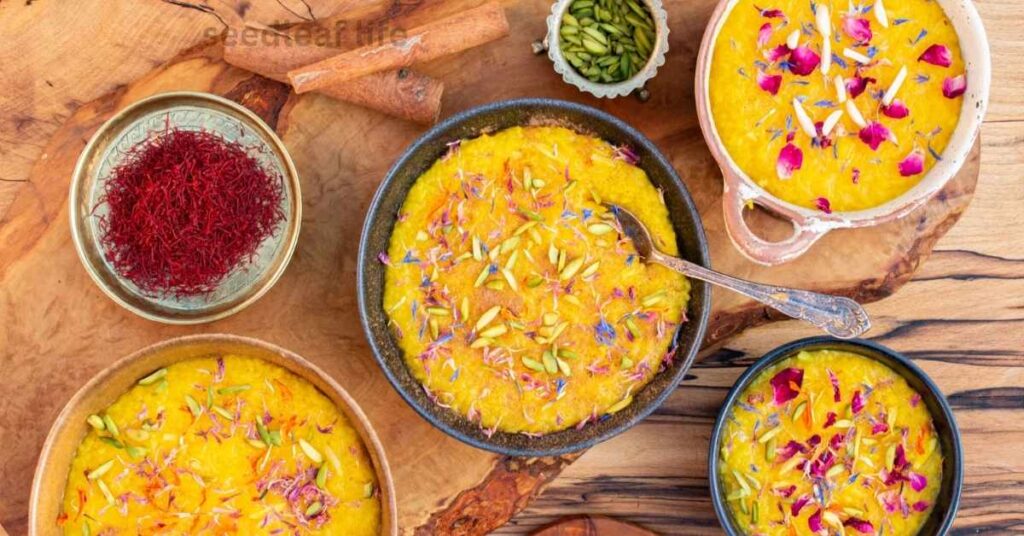
Saffron’s taste is as golden as its color — rich, complex, and impossible to imitate. Let’s explore what saffron really tastes like, where does saffron grow to develop such unique flavor and aroma, and how to use it perfectly in your recipes without going overboard.
Flavor Profile and Aroma of Saffron Threads
- Unique and unforgettable: The flavor of saffron is a delicate balance of sweet, earthy, and floral notes. Some even describe it as having a subtle honey-like warmth mixed with a hint of bitterness.
- A taste of sunshine: Saffron’s aroma is equally captivating — floral, slightly hay-like, and deeply comforting, almost like a stroll through a sunlit field.
- Transforms every dish: Whether added to rice, desserts, or soups, saffron infuses a rich depth that lingers beautifully on the palate.
- Where does saffron grow best? In warm, dry climates like Iran, Spain, and Kashmir, those unique conditions help shape its signature flavor and aroma.
Every thread of saffron carries a story — a mix of sunshine, soil, and centuries of tradition captured in one spice.
How Much Saffron to Use in Cooking Without Overpowering Dishes
- A pinch is enough: When it comes to saffron, less is more. Just 10–15 strands can flavor an entire pot of rice, soup, or curry.
- Always infuse first: For the best color and aroma, soak the threads in warm water, milk, or broth for about 10–15 minutes before adding them to your dish.
- Avoid overusing: Too much saffron can create a bitter aftertaste and overpower the natural flavors of your food.
- Adjust to taste: Start small, taste as you cook, and increase gradually — saffron rewards patience and precision.
The secret to saffron’s magic isn’t in quantity, but in balance — just the right touch can turn a simple dish into a masterpiece.
Final Thoughts – The Beauty of Growing Saffron and Its Global Journey
In closing, the journey of saffron is as fascinating as the spice itself. From the sun-kissed fields of Iran to the vibrant markets around the world, saffron brings colors and flavors alive. It thrives in various climates, but its heart lies in places like Spain and India.
Each strand tells a story, connecting cultures and traditions. So, whether you’re adding it to a dish or using it in remedies, remember the beauty of where does saffron grow — from the sunlit fields to your kitchen. Why not explore this amazing ingredient further in your cooking today?

